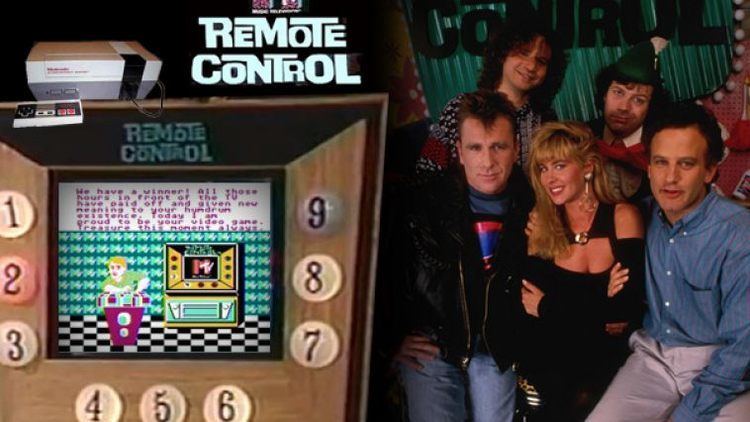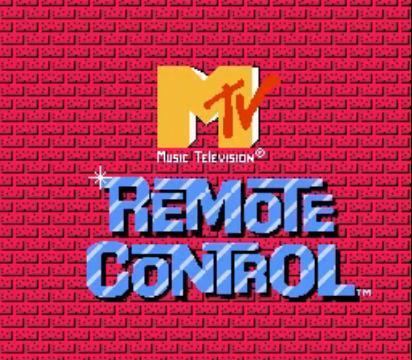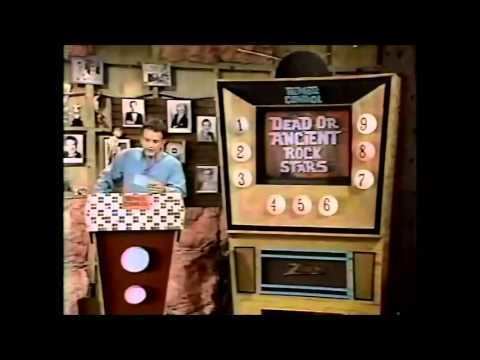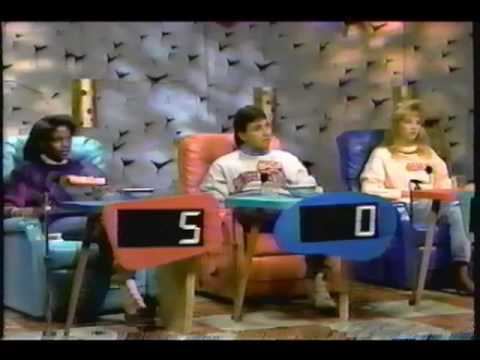7.6 /10 1 Votes
7.3/10 TV Country of origin USA Running time 30 Minutes Final episode date 13 December 1990 | 7.7/10 IMDb No. of seasons 5 First episode date 7 December 1987 Number of seasons 5 | |||||||||||||||||||||||||||||||||
 | ||||||||||||||||||||||||||||||||||
Starring Craig VandenburghJohn Ten EyckAdam SandlerDenis LearyRoger KablerSteve Treccase Location(s) Matrix StudiosManhattan, New York (Seasons 1-2 and 4-5)Disney-MGM StudiosOrlando, Florida (Season 3) Similar Game show, Tough Crowd with Colin Qui, Singled Out, Saturday Night Live, Jimmy Kimmel Live! | ||||||||||||||||||||||||||||||||||
Remote control july 4 1989
Remote Control is a TV game show that ran on MTV for five seasons from 1987 until 1990. It was MTV's first original non-musical program. New episodes were made for first-run syndication from 1989 until 1990 which were distributed by Viacom. Three contestants answered trivia questions on movies, music, and television, many of which were presented in skit format.
Contents
- Remote control july 4 1989
- Mtv remote control 1989 full episode
- Cast
- Premise
- Main game
- CategoriesChannels
- Penalty channels
- Snack Break
- Off the Air
- Lightning round
- Final question Season 5 and second half of syndicated version only
- Grand prize round
- Celebrities
- Foreign versions
- Merchandise
- References

The series was developed by producers Joe Davola and Michael Duggan.
It was directed by Dana Calderwood.
Mtv remote control 1989 full episode
Cast

Remote Control was hosted by Ken Ober and featured Colin Quinn as the announcer/sidekick. John Ten Eyck played several walk-on parts, joined in later seasons by Adam Sandler, Denis Leary, and Roger Kabler. Steve Treccase provided music; Marisol Massey (Season One), Kari Wührer (Seasons Two and Three), Alicia Coppola (Season Four) and Susan Ashley (Season Five) were the hostesses. Although uncredited, Jani Berry provided the off-camera voice as the character of Ken Ober's mother.
Premise

The show's premise was that Ober desperately wanted to be a game show host and set up his basement (at 72 Woopingkof Lane; the spelling was indicated by a street sign prop seen on the set) as a television studio. The opening theme song sketched out the scenario:

"Kenny wasn't like the other kids (Remote Control)
TV mattered, nothing else did (Remote Control)
Girls said yes, but he said no (Remote Control)
Now he's got his own game show (Remote Control!)"
Shows were sometimes interrupted by the disembodied voice of "Ken's mother," and the studio was indeed set up to resemble a basement, complete with a washer and dryer, cheesy bric-a-brac, and a giant Pez dispenser that resembled Bob Eubanks.
The basement was a mainstay of the show throughout its run; however, its cheesy decor was "rearranged" slightly every season. The contestants sat in leather La-Z-Boy recliners with seat belts (their purpose explained below), complete with retro kidney-shaped tables and scoreboards, facing host Ober and his retro-styled Zenith television. Behind Ober were autographed pictures of his idols, game show hosts such as Eubanks, Bob Barker, Bill Cullen, Bert Convy, Monty Hall, and Tom Kennedy. Musician Steve Treccase set up his keyboard behind a cluttered bar, at which Quinn and the hostess usually sat for the duration of the show. More clutter could be found around and behind the audience, very frequently including props used in previous seasons. Finally, the contestants' chairs were placed in front of breakaway walls, through which they were pulled if they were eliminated.
Main game
Three contestants sitting in lounge chairs would select one of nine channels on a big-screen television that stood beside Ober, using their TV remote control units; each channel represented a subject having to do with pop culture. Sample channels used on the show were "The Bon Jovi Network", "Brady Physics", and "Dead or Canadian". Contestants answered a series of toss-up questions from those subjects to earn points, using signaling devices to ring in. Most channels contained three questions of increasing value, although certain special categories would have either one or two questions. The identity of each channel was only revealed when it was first chosen during a round.
In the first round, the three questions in a standard category were worth 5, 10, and 15 points, in that order. Point values were doubled for the second round. The contestant who answered a question correctly could either stay with the current channel or select a different one; after the last question in a channel was asked, it was taken out of play for the rest of the round.
Categories/Channels
Several categories in each game dealt with specific television shows or genres. Categories such as "Brady Physics" (and later "Brady Metaphysics"), "The Today Show Time Machine", "Leave Out the Beaver", "Inside (celebrity's name)" and "The Bon Jovi Network" were standard academic categories with questions presenting humorous situations involving the characters or celebrities named in the category.
Other categories included:
The "MTV" category, containing questions relating to music and music videos, generally appeared in almost every round.
Several categories were performance-driven:
Penalty channels
There were a handful of "negative" channels that cost contestants points and/or subjected them to an unpleasant experience.
Snack Break
At the end of the first round, the contestants were treated to a snack; however, as they were guests of an unconventional host, the snacks were delivered in unusual ways. In the vast majority of shows, the contestants were provided with bowls which they held over their heads to catch the snack, which was dumped onto them from above. When the nature of the snack made this method impractical, it would be lowered from above on trays or delivered by the hostess. In some episodes, each contestant was hit with a pie in the face.
During the first season, the Snack Break occurred in the middle of the round, and the contestant in the lead at that point had the chance to win a small prize by correctly guessing which of three numbered refrigerators it was located in (similar to Let's Make a Deal). The other two each held a revolting food item.
Off the Air
One of the signature features of Remote Control was the way in which contestants were eliminated from play. After round two, the TV went "Off the Air" (accompanied by a siren sound effect and the studio lights flashing on and off), and the contestant in last place at that moment was also thrown "Off the Air" and eliminated from the game. Eliminated contestants were removed immediately, chair and all (hence the seat belts). Beginning late in the first season, the audience would also sing a "goodbye song," typically "Na Na Hey Hey Kiss Him Goodbye," "Hit the Road Jack," or "Get Off My Show" (to the tune of "Get Off My Cloud"), while said contestant was being ejected. After a contestant was ejected, he/she would be tormented by stagehands administering various annoyances behind him/her while an unrealistic screaming sound effect played. The ejections were accomplished in a variety of ways.
The setup in the first season was very basic. All three contestants were seated in front of breakaway sections in the wall behind them. Upon elimination, the losing contestant was simply pulled in their chair through that section of the wall, which would fall backwards allowing the chair to continue sliding behind the stage. Upon being pulled through, a black curtain was dropped concealing the contestant. Most of the time this was accompanied by the camera shaking violently and a "static" effect to simulate the TV (and the contestant, as mentioned by Ober) going "Off the Air." On occasion, the chair would return through the wall with the contestant replaced by a skeleton or something else indicating that he or she had been "killed."
The second season was the first to feature three different kinds of eliminations; also, the camera effects were removed. The contestant on the left side of the stage was seated in front of a seemingly normal brick wall. If they lost, his/her chair was pulled backwards and upon hitting the wall a trap door would swing open to allow the contestant to be pulled backstage. The door was then shut to "trap" the contestant behind the wall. The contestant in the middle was in front of a doorway lined with blue wallpaper. Upon elimination, he would be pulled back and rip through the wallpaper, with a black curtain lowered in front of the contestant to keep him hidden them from view. The contestant on the right was in the infamous "flipper" chair, which was yanked upwards and backwards so that the stage floor was now the wall from the vantage point of the audience.
Seasons 3 and 4 presented some minor modifications. The "flipper" chair was now on the left side of the stage. The middle chair was in front of a fake brick wall which had a breakaway section similar to the ones used during the first season. Just like in prior seasons, a black sheet was dropped down to conceal the contestant from view. The contestant on the right side was in front of a typical looking wall decorated with shelves, pictures, and a dartboard. When this contestant lost, his/her chair would be flung backwards, hitting the wall and spinning it around 180 degrees. The backside of the wall (now seen on stage) looked like the outside of a house, with siding and a garden hose (as to imply that the contestant had been ejected from the basement to outside.)
The fifth and final season presented some minor modifications as well; the black curtain behind the breakaway wall was replaced with a black wall with "jail bars," and the wall rotated vertically as the contestant on the right side was being pulled through it.
In Spring Break episodes, contestants were seated in folding lawn chairs which were placed on platforms on the edge of a swimming pool. All three contestants were eliminated in the same manner if they went "Off the Air." The platform would sink forward slightly, folding up the lawn chair just a little (and making it more difficult for contestants to run away if they chickened out, as they were not strapped in for safety purposes.) The hostess would then walk over to a lever in front of the contestant, wave bye-bye to them and pull the lever that released the platform, sending the seated contestant tumbling backwards into the pool. This concept was dropped in later Spring Break episodes and replaced with the losers being pushed or thrown into the pool by stagehands.
On at least two occasions (including a 1988 Christmas episode in which the three contestants were actors playing the "Three Wise Men"), the contestants performed so badly in Round 1 that Ober decided to have them all yanked "Off the Air" at the end of it. The scores were reset to zero, and three new contestants took their places to complete the game.
Lightning round
During the first season, after the TV went "Off the Air", gameplay continued as normal with the remaining two contestants until time expired. Beginning with the second season, this format was scrapped for a "lightning round" to determine the winner.
In seasons 2–4, the two remaining contestants competed in a 30-second speed round entitled "Think Real Fast". Typically, this was a fill-in-the-blank or spot-the-errant-word format. For example, Ober would announce a movie, TV show, or song title that had one word replaced with an incorrect word, and contestants had to come up with the correction. Each correct answer scored 10 points. The high scorer moved on to the bonus round, while the runner-up was eliminated in a manner similar to the third-place contestant. Also, in seasons 2–4, if there was no clear third-place contestant (i.e., a three-way tie or a tie for second place) when the TV went "Off the Air", nobody was eliminated and all three contestants played "Think Real Fast". In this instance, both losing contestants were removed simultaneously; Ken termed this event a "double yank".
In the fifth season, all three contestants played a different version of the lightning round called "This, That, Or the Other Thing", although it was not the last round in the game. All questions now had one of three answers that Ober would list before the round started. These were usually people or characters who shared a common name (e.g., "Andy Taylor, Andy Warhol, or Andy Rooney"). Contestants had 20 seconds to ring in and answer as many questions as possible. After this round, the TV immediately went "Off the Air" and the third-place contestant was eliminated.
Final question (Season 5 and second half of syndicated version only)
In the final season, the two remaining contestants bet any or all of their current score on one final question. Host Ober read a question, usually a math problem, and the contestants had 20 seconds to write down their answers, during which a strange attention-derailing act was performed. When time expired, the contestants' answers and wagers were checked; a correct answer awarded the wagered points to the contestant, while a wrong answer deducted as many points.
The surviving contestant with the highest score won the game and a collection of prizes, and went on to the Grand Prize Round. In the event of a tie after the last round, Ober would pull a tiebreaker question from the giant Pez dispenser in the corner; a correct answer won the game, while a wrong answer lost it.
Grand prize round
MTV Version (first 4 seasons): The contestant was strapped to a "Craftmatic Adjustable Bed", facing a wall of nine TV sets (some turned sideways or upside down) on which music videos would be playing. The contestant had to identify the artist in each video, with a prize being awarded for every correct answer. Correctly identifying all nine artists within 30 seconds won the grand prize, usually a car or a trip ($5,000 in celebrity episodes). Before the clock started ticking, the contestant was given a split-second glimpse of every video at once.
Syndicated Version ("Wheel of Jeopardy"): Due to copyright issues, music videos could not be used on the syndicated episodes. Instead, the contestant was strapped to a spinning horizontal wheel surrounded by 10 numbered television monitors and was asked 10 questions (usually about TV). For each question successfully answered, the contestant won a prize, and the corresponding screen would display "Grand Prize". After all questions had been asked, the wheel was stopped, and if the contestant's head pointed to a screen that displayed "Grand Prize", he won the day's top prize in addition to any prizes for his correct answers. A contestant who correctly answered every question automatically won the grand prize. A similar bonus round was used on the British version.
MTV Version (season 5): The "name the artist" round was modified to more resemble the syndicated bonus round. The contestant was strapped to a spinning metal wheel placed at a 45 degree angle, with a single TV above it and another below it. The nine videos were shown in succession simultaneously on both monitors, and the contestant had to guess all the artists in 40 seconds to win the grand prize.
Celebrities
Celebrities that appeared on the show included:
Celebrities that played the game:
